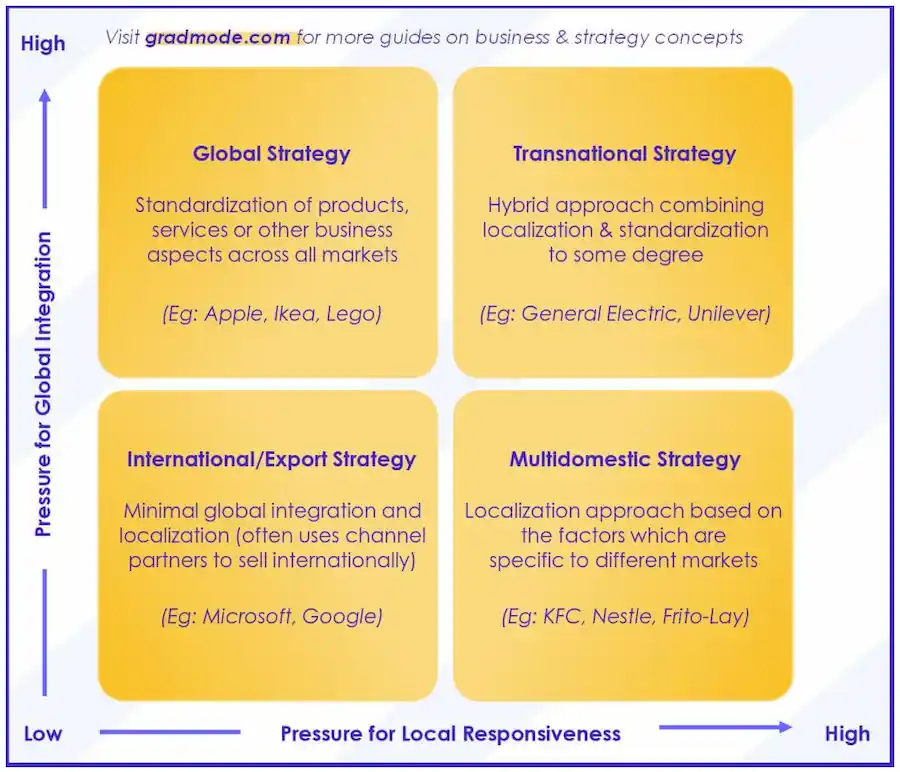Table of Contents
Multidomestic Strategy Definition
Multidomestic strategy is one of the approaches taken by companies operating in different countries, in which the company customizes the products, services, marketing efforts or other aspects of the business to better suit local variables in each of those markets. Hence, a multidomestic company is one which tries to customize its business model for the different countries which it operates in.
How does a Multidomestic Strategy work?
Multidomestic strategy works by prioritizing a higher level of responsiveness to local trends and preferences. As a trade-off the company would not increase the scale of global integration of its offerings or value-adding activities. The main characteristics of multidomestic strategy are that it requires giving up efficiency of cost and operations (which standardization offers) and instead choosing to connect more closely to customers in each market by catering to their specific requirements and expectations. The logic behind this is that adapting to local variables in this well will help improve sales performance in those countries, which would justify the increase in costs.
As part of adapting to local market variables, some of the main factors a multidomestic strategy must consider include:
- Market trends
- Regulatory and legal requirements
- Consumer tastes
- Consumption patterns and preferences
- Cultural differences
- Language barriers
Multi-domestic Strategy Concept
One of the main theories cited in strategic management literature on multidomestic strategy is the work of Bartlett & Ghoshal (1989). Their framework compares the level of responsiveness of a company to local market variables against the level of global integration to identify different internationalization strategy alternatives for which companies can consider. Although their initial theory only focused on three main internationalization strategies, later strategy management practitioners added a fourth one, known simply as ‘international strategy’ or export strategy.

Multidomestic Strategy Examples
KFC is one of the best examples of a multidomestic corporation since it makes changes to its menu based on different local cuisines of popular dishes there. In fact, KFC’s menu in China has nearly double the number of items as a typical outlet in the US. As a result, the size of the kitchen and the number of staff at each store is also nearly double of what is typical in its outlets in the US.
Other examples of multi domestic strategy include Nestle and Frito-Lay. The former (Nestle) has an extensive history and tradition of empowering managers in local subsidiaries to take whatever decision they deem appropriate for their regions. We may not necessarily agree with the ethics behind some of the decisions taken by this company, but there’s no denying that their localization strategies have been a success. So much so that a lot of consumers in different countries share a common assumption that Nestle is a local company. The latter (Frito-Lay) which is a producer of foodstuff such as snacks and chips even goes so far as to create entirely new snack products to suit the tastes and preferences of certain local markets.
On the other hand, there are cases of some companies which previously had an extensive portfolio of localized products in different markets but then scaled back the level of localization and shifted more towards a transnational strategy in recent times. An example of this is Unilever which at one point removed nearly 1,200 brands (which were mostly local) from its overall product portfolio in order to focus on the remaining 400 brands. Another example of this is Phillips which also shifted towards a transnational strategy after previously having followed a multidomestic approach.

How does it differ from other Internationalization Strategies?
Comparisons are often made between multi-domestic strategy, transnational strategy, international strategy, global strategy and globalization strategy. These terms are sometimes used interchangeably, but from a strategic management theory perspective, each of these are fairly distinct. We outline the differences between these in the detailed table below.
| Multidomestic Strategy | Global Strategy | Transnational Strategy | International Strategy (Export Strategy) |
| This concept focuses specifically on the decision to localize products, services or other business aspects for each specific market | This concept focuses specifically on the decision to standardize products, services or other business aspects across all markets | This approach has a combination of both localization and standardization to some degree | This strategy does not pay special attention to localization or even global integration. Instead the company relies on its home-country capabilities and innovations to sell products to a wider, global market |
| The primary aim of this strategy is to better serve local preferences, customs, or market trends to achieve higher sales through better customer satisfaction | The purpose of using a global strategy is to standardize the brand image, decrease costs and achieve other operational efficiencies | This is typically aimed at catering to a broad range of customers by providing products or services which meet global standards, and may only need to be tweaked minimally to suit local market factors | The main goal of this approach is to have minimal global integration and localization and instead relying on channel partners such as overseas suppliers, distributors or franchisees to sell products and services internationally |
| Might be more appropriate when a company operates in many markets that have strong local customs and traditions | Could be better suited to companies that rely on brand recognition and standardization of processes | Typically adopted by companies looking to reach a broader range of customers as | This strategy is used when a company does not face much pressure for global integration or local responsiveness |
| Higher costs are involved because this sacrifices cost efficiencies to gain greater product reach | Comparatively lower costs as it limits customer reach but provides better cost efficiencies | Hybrid strategy carries much higher costs, so usually, it is the large players or industry leaders who can afford this approach | This strategy should have the lowest costs in theory as a company only focuses on its production and export without any effort of global integration or product/service customization |
| Does not necessarily contribute to global brand awareness and recognition | Improves global brand awareness and recognition | Contributes to some extent towards better global brand awareness and recognition | Can potentially contribute to better global brand awareness and recognition |
| Commonly seen in marketing-oriented companies such as those dealing in food products | This approach is well-suited to companies with a strong brand image, global recognition and demand which they can capitalize on without needing to localize their products or services | These are more common in companies dealing in commodities with established standards such as cement | This approach is suitable for companies that do not want to commit resources to heavy investments, or those which have strong brands and don’t feel a pressure to integrate globally or customize their products and services |
| Examples include companies like KFC, Nestle, Frito-Lay etc. | This includes companies such as Apple, Ikea, Lego, L’Oreal etc. | Some of the companies taking this approach are General Electric, Samsung and Unilever | Example of this strategy is seen with companies like Microsoft and Google |
Multidomestic Strategy Vs Global Strategy
It should be clear from the figure and comparison table that multidomestic strategy and global strategy are polar opposites of each other. Multidomestic strategy aims to cater to the preferences, customs or market trends of specific markets, while global strategy focuses on standardizing marketing and operations activities. The former approach helps companies compete more aggressively in markets where there are strong local customs and traditions, which in turn dictate or at least influence customer preferences.

On other hand, the latter approach lets a company standardize its brand variables on a global scale, which ensures better brand recognition. At the same time, standardization of products or services helps companies keep costs down due to less need for customization. A global strategy is also known as a ‘hub-and-spoke model’ and the reason for this is because this strategy is typically characterized by a high level of centralization. An example of a company with a strong global strategy is Ikea, which offers almost the products across all the markets that it operates in.
Multidomestic Strategy Vs Transnational Strategy
Based on the differences between multidomestic versus global strategy, it can be inferred that most companies will typically take a decision between focusing on one approach or the other. However, this is not to say that the two are mutually exclusive. In fact, a lot of companies adopt a hybrid approach combining the two.
This is known as a transnational strategy and the way the way this works is that the company localizes some aspects of its business to suit local market preferences and trends but also standardizes other aspects to preserve its brand recognition globally. Typically, this is done by standardizing upstream activities such as procurement and production, while localizing certain downstream activities like marketing, sales and distribution. However, such kinds of hybrid strategies can often result in additional costs and expenses, while also requiring more time and resources than one of the other approaches. At the same time, transnational strategies maximize the knowledge exchange between different business units and subsidiaries. The impact of such knowledge sharing is more noticeable when there are strategic synergies between the subsidiaries.
Multidomestic Strategy Vs International Strategy
As it can be inferred from the comparison table above, multidomestic strategy is a specific type of strategy within a broader international strategy. However, if considering the view that international strategy is a reference to export strategy, then the obvious difference is the level of responsiveness between the two. While both strategies have a low level of global integration, the degree of adapting to local trends is high in a multi-domestic strategy and quite low in international strategy. Additionally, in an export strategy, most of the activities (if not all) are centralized at the company’s headquarters in the home country. Even if there are subsidiaries, they function more as a channel partner would, which means that they role might even be limited to just distribution of the products.
International or export strategy is suited to large companies like Google and Microsoft since they do not need to localize or integrate globally. This is because they are well recognized and have extensive supply chain and distribution channel partners (such as computer retailers who bundle Windows in the case of Microsoft, and phone companies which run on Android for Google). International export strategy is also seen at a smaller scale with export-oriented companies, such as those which sell through international ecommerce websites like Alibaba.com
Multidomestic Strategy Advantages and Disadvantages
Companies must carefully weigh the pros and cons of multidomestic strategy well before taking a decision on adopting this as their main internationalization approach.

Multidomestic Strategy Benefits
The major advantages of a multidomestic strategy are listed below.
Helps Achieve Greater Sales Conversion & Customer Satisfaction
- This strategy approach helps companies better serve the requirements and expectation of local consumers, which can result in better conversion of sales and a higher level of customer satisfaction
- It also helps a company be more in tune with local market customs and traditions, which helps the company gain better acceptance and less resistance from local consumers. This can be especially beneficial when the host country of the company has a high cultural distance from other markets.
Provides Higher Flexibility and Responsiveness to Market Trends
- As mentioned above, a multi-domestic strategy also helps companies be more responsive and flexible in reacting to changes in local market trends
- In fact, in extreme cases, such an approach may even be essential for success in certain situations which rely on adapting and confirming to local market requirements. The biggest example of this is companies looking to operate in countries like China or Japan. This is because the consumers in these countries identify strongly with their culture and traditions so a failure to localize can result in poor performance in these markets. Even large companies such as eBay, Amazon, Google and Uber could not establish a foothold in China for this reason and the previous one.
- Another benefit gained through the variety of product and service offerings in this strategy, is that it can offer a degree of protection against changing market trends. This is especially noticeable when considering the fact that global brands sometimes feel a ‘ripple effect’ in which a problem with the brand in one country spills over and causes negative consequences in other markets too.
Supports Faster Decision Making
Multidomestic business strategy often requires the local subsidiaries to be given a great level of autonomy. This brings with it all the standard benefits of decentralization, including less burden and efforts required from a central head office. This effectively means that decisions can be taken more quickly without relying on input of head office management.
Offers More Strategy Options
- Multidomestic business strategy also holds value in market expansion contexts since the acquisition of local brands is a commonly used market entry strategy.
- Multidomestic strategy is also beneficial for companies which are looking for countries from where input variables can be acquired more cheaply.
- Localization of products and services often requires companies to tap into the local labor market and seek local expertise, which could even open up opportunities for better factors of production or input such as land, labor, capital or resources.
Helps Comply Better with Local Political & Legal Requirements
Multidomestic strategies may also be essential for survival when a company is faced with strong political and legal pressures. The biggest example of this in recent times is the pressure put on companies like Google and Apple by European regulators to conform to local expectations on aspects such as data privacy, right to repair etc.
Drawbacks of a Multidomestic Strategy
Here is a list of the major disadvantages of multidomestic strategy.
Can Lead to Inefficient or More Expensive Operations
- Multidomestic strategy requires giving up certain competitive aspects such as efficiency and economies of scale and scope. These competitive advantages are often gained through a standardization of products and services, while a multidomestic strategy goes in the opposite direction.
- Product localization or customization are often expensive due to the need to have more variety in products and services (when looking at the overall portfolio of the company).
- A multi-domestic strategy aiming to increase product and service customization may not be well-suited to certain industries such as engineering or construction since they typically rely on rigorous standardization
Required Higher Time and Effort Investments
- Apart from needing to invest time, effort and money into researching the trends of each local market, there is a need to once again invest in researching and developing suitable products catering to each of these. There are also additional operational and logistics costs associated such as the need to keep higher inventory due to greater product varieties.
- There is often a duplication of efforts between subsidiaries in different companies because multidomestic strategy typically requires giving greater level of decentralization and autonomy to local branches.
Results in Less Knowledge-Sharing between Subsidiaries
Additionally, a multidomestic business strategy often implies less knowledge-sharing between different subsidiaries. This is because each of these subsidiaries would be looking to adapt their strategy and style of operating to local variables without really considering what other subsidiaries may be doing.
Potentially Leads to Brand Dilution and Tough Competition
- The company faces a certain degree of brand dilution since the company’s products or services would not be the same in all its operating regions. In other words, a multidomestic strategy offers less contribution when aiming to build a stronger global brand.
- A multidomestic business strategy might also be difficult for certain companies to pull off successfully. An example of this is if there are already many strong and well-established local players who are serving the local requirements and preferences well.
References
Bartlett, C.A., Ghoshal, S. (1989). Managing Across Borders. The Transnational Solution, Boston, Mass.: Harvard Business School Press

